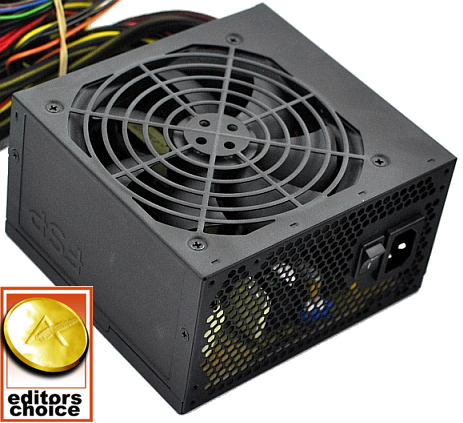350-450W Roundup: 11 Cheap PSUs
by Martin Kaffei on July 3, 2012 1:30 PM ESTConclusion
Some PSUs have no right to exist. The Sinan Power VP-430 430W at €22.40 (about $28) belongs in this classification if you want a reliable PSU. The Sinan Power is a ~215 watts power supply without active power factor correction—not to mention the fact that the efficiency is always below 75%. Sinan Power offers nothing more than three SATA and a few HDD connectors on very short cables. Once again it can be stated that you get what you pay for!
The be quiet! System Power 350W at €29.75 (about $37) is one of the 350W units we can recommend for Office use. The downside of the PSU is that there is no connector for graphics cards, but this shouldn't hurt too much. Three SATA and HDD connectors are provided and there is a floppy connector at 75cm. be quiet! uses Taiwanese capacitors like most manufacturers in this roundup. be quiet! will be finally entering the US market later this year which is a good news for enthusiasts as they deliver the quietest PSUs in Germany.
Thermaltake offers a few power supplies which come up to expectations but the Thermaltake Smart AP-430P 430W at $61.99 didn't do well as the efficiency was low. 83.64% is the highest value we measured during the test. During 20% load Thermaltake didn't even surpass the minimum requirement for 80 Plus. You get the usual set of accessories and cables, but there are no unique features or remarkable results, which should be mentioned.
The Rosewill Green Series RG430-S12 430W at $44.99 provides many connectors except the PCI-E plugs. The model reached up to 84% efficiency and more than 40mV ripple and noise on the smaller rails. This should be avoided next time. However, the PSU stays stable all the time and comes with several extras such as cable ties. In summary, the RG430-S12 is a decent mainstream PSU.
The OEM models by FSP (FSP400-60APN 230V version and FSP400-60GHN(85)) performed well in our test. All the modern FSP PSUs we've reviewed have no problems with ripple and noise, and that trend continues here. However, both models provide just a 4-pin CPU connector and 6 to 9 peripheral plugs. Additionally, you get only one 6-pin connector for graphics cards. Like most PSUs in this roundup both models have all important safety functions including OCP and a common forward converter. All in all we have to criticize the cable configuration, which plays an important part when building a PC.
| Comparison: Max. Efficiency | |
| PSU | Efficiency (230VAC) |
| FSP Raider | 90.54% |
| FSP400-60GHN(85) | 86.76% |
| Enermax NAXN | 86.39% |
| Rasurbo RAP | 86.27% |
| be quiet! System Power | 85.86% |
| Corsair CX430 V2 | 84.90% |
| FSP400-60APN | 84.64% |
| Rosewill Green Series | 83.73% |
| Thermaltake Smart | 83.64% |
| Sinan Power VP-430 | 74.13% |
The Corsair CX430 V2 430W at $39.99 is an affordable power supply with low ripple on all rails. The number of connectors and their distribution is satisfying as well. During the load test the regulation of the output voltage is sufficient, and the efficiency is decent for an 80Plus model. The contents of the package are also very welcome. The power supply uses a well known layout from CWT and it's a cheaper design. The relatively low-end capacitors are acceptable for a PSU in this range. Under load the power supply is clearly audible, reaching up to 27 dBA.

The Rasurbo RAP350 350W at €30.84 (about $39) and RAP450 450W at €43.59 (about $55) use Taiwanese capacitors from Teapo, there's a lot of space for cooling and airflow, and they've chosen better MOSFETs than Thermaltake. The RPMs are tolerable up to 50% load causing a low fan noise. In terms of voltage stability, the 3.3V rail measures 3.19V during our overload scenario. All the other outputs are closer to their optimal values. The package includes all important extras and 86% efficiency is pretty nice. In addition there are two PCI-E connectors at the 450W model. We are pleased to present Rasurbo with our Bronze Editors' Choice award.

The Enermax NAXN ENP450AWT-B 450W (no price available) is very efficient and stable. In addition Enermax provides one more SATA connector and longer cables than Rosewill which is usually more important than a few additional HDD plugs. There is no heavy increase in acoustic noise during operation, but the fan already starts at a high RPM. Beside this we couldn't find any major flaws. Inside we found the same double forward topology Corsair used. However, Enermax has more efficient components and the cable configuration is more extensive. In addition the NAXN used a better looking cable sleeving, probably the best in this roundup. Enermax also performed well, reaching low ripple and noise results and an ideal voltage regulation. Last but not least we can recommend the PSU because of features like the HeatGuard and many safety functions. Enermax deservedly earns our Silver Editors' Choice Award for providing a (nearly) flawless product.
The FSP Raider 80Plus Bronze 450W at a MSRP of $55 is the most expensive PSU in this roundup for the simple reason that they offer the best product. FSP provides two PEG connectors instead of one (which is enough to run either a lower-end SLI/CF setup or a single high-end graphics card with two PEG jacks), a 5-year warranty and a very high efficiency. In fact the efficiency was ~4 percentage points above the second best result (230VAC) and way above the necessary values for 80Plus Bronze (Silver at 115VAC, Gold at 230VAC). FSP integrated well chosen components and the well known active-clamp design. Moreover FSP implemented all safety functions including OCP. Five SATA connectors and a very long CPU cable perfect the PSU. The fan's RPM and the load rise equally, but the noise is still acceptable compared to the Aurum models. We’re awarding FSP our Gold Editors’ Choice award.











67 Comments
View All Comments
CeriseCogburn - Sunday, July 8, 2012 - link
These are all elitist power supplies, not you get what you pay for power supplies.Try to find 6 pin + 6+2 pin on a 450W anywhere... they are RARE.
This is NOT the cheap power supply review - this is the name brand poular low wattage PS review.
marvdmartian - Monday, July 9, 2012 - link
Sorry, but were you looking for a review of, say, a PowMax power supply?? Not sure why you refer (twice, in two posts) to these power supplies as "elitist.Trust me, you don't need to make $100K/year salary to own these. Especially the Corsairs, which are regularly on sale for <$20, after mail in rebate.
CeriseCogburn - Tuesday, July 10, 2012 - link
I just said why, but you're "not sure" why, probably the "not sure" from the movie Idiocracy.Black1969ta - Saturday, July 14, 2012 - link
more like a member of the Cabinet.rickcain2320 - Thursday, July 12, 2012 - link
Don't ever mention PowMax in my presence ever again, speak not that word.zero2dash - Tuesday, July 3, 2012 - link
Very surprised to see the VP-450 not make the list of candidates.Between what you have here, I've used both the Corsair CX line and the Rosewill Green line. After a disappointment with the CX and coil whine, it was replaced with a Rosewill RG and I couldn't be happier.
Bottom of the barrel, me personally I'd go with either the RG or now the Antec VP-450.
I'm not spending $50 on a <500w PSU, sorry. You can get a decent 500-600w, sometimes having to wait on a rebate or a coupon code but nonetheless - Antec NeoEco, Antec HCG, even a Corsair TX2, for not much more than that.
Martin Kaffei - Tuesday, July 3, 2012 - link
Speaking of prices. The Raider is not available yet and the going price will be much lower than the MSRP.Antec didn't reply to my email and I wasn't able to get the US version in Germany. Anyway, I will try to get cheap Antec PSUs next time. Thank you for your comment.
JonnyDough - Wednesday, July 11, 2012 - link
That's because you're a moron. Just because it supplies lower wattage does not mean that it is any less important or valuable than an 800w power supply. Voltage regulation is pretty simple, getting no ripple and getting good efficiency is a bit harder. You pay for quality, not for wattage. If you want junk, then buy junk. This was for people who are serious about their PCs and want them to work well and last for awhile.Lonyo - Tuesday, July 3, 2012 - link
While this is a nice article on low(er) power PSUs, would it be possible to see some sort of real world enthusiast article which focuses on NAS/HTPC boxes and power?For instance, there's a Zotac Atom DTX board with 6 SATA connectors and two PCIe slots (x1 and x16 I think). Theoretically you could have 14+ HDDs hooked up (killer NAS for the motherboard form factor).
Something looking at the power of a NAS or HTPC with regards to PSUs would be nice. A 70% efficient 400w PSU would consume a lot more (relative) power on a low wattage box than something like a DC power supply with adapter (from experience), since they can get closer to 95% I believe in lower power situations.
It would also be nice to see peak (boot) power for such a HDD loaded system in terms of what sort of PSU is required to boot the thing without staggered spinup.
I personally made a G620T system with a 250w mATX PSU, which I swapped out for a PicoPSU, and dropped power use from about 35w IIRC, to 25w, which is a lot in % terms, although in absolutes it's not all that significant.
Just a thought for an article if there is the desire. I definitely am interested in low power HTPC and NAS boxes (considering building a NAS box with the above mentioned Zotac DTX board in the coming months).
Martin Kaffei - Tuesday, July 3, 2012 - link
I'm able to review all PSUs with AC input and DC output.SFX, TFX PSUs, Picos in combination with laptop adapters.
How about some 300W SFX units and 90W adapters? Most PicoPSU are very good but the adapter is usually a bit of a problem. Nobody takes a look inside. Quite often the quality is abysmal .